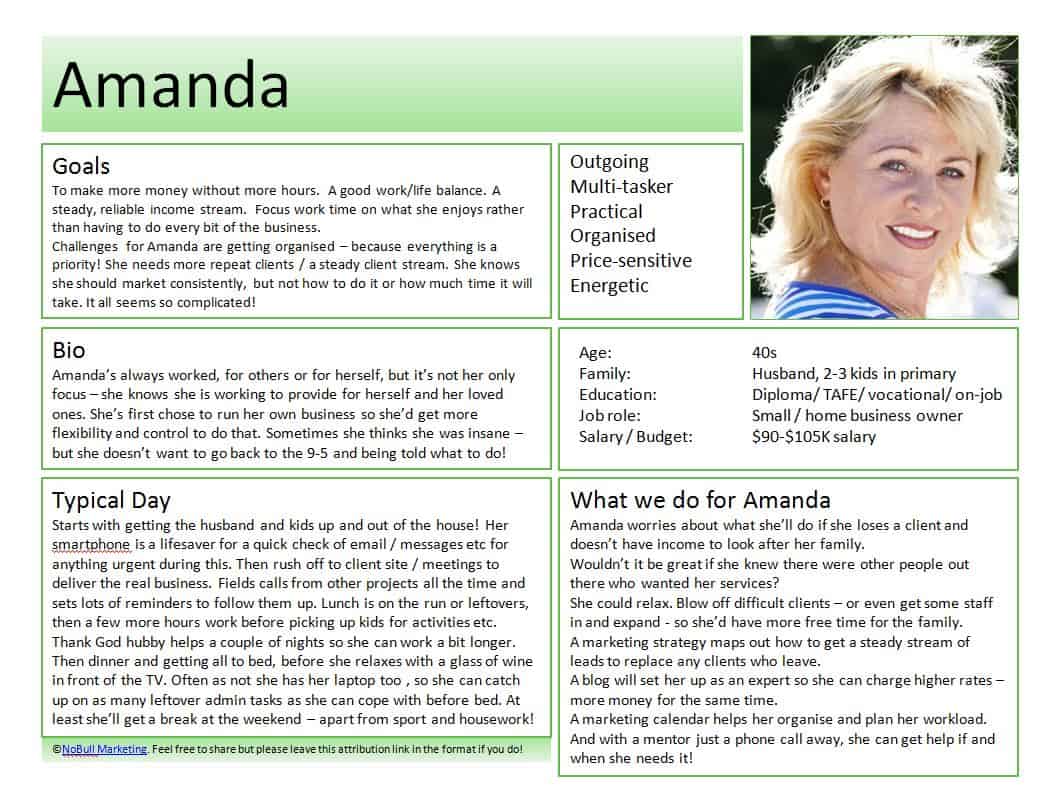If you’re not using personas in your marketing, now’s a good time to start! So here are some practical tips for creating personas.
Why bother with creating personas?
You already know who your target market is. You are focused on them right now. But are you as focused as you could be? An earlier post explored how shifting to persona-based marketing helped triple revenues at RSVP, but if you don’t have time to read that now, here are four key benefits of personas. (Or you can skip straight to how to create a persona.)
- You know who you’re talking to!
Think about it. If you were asked to speak at an event, you’d want to know who’s attending. So you can prepare your material to match their needs and interests. Why wouldn’t you do the same with all your marketing materials? Especially blogs and newsletters, which you’re sending out regularly.
- It’s easier to create and sanity-test your content.
We have a persona called Amanda. She’s a multi-tasking time-poor business owner who wants to promote her own business but needs practical advice and hand-holding along the way. Is she going to be interested in this blog post? We hope so.
We have another persona called Darren. He’s a time-poor business owner too, but he’s not the least bit interested in marketing. He wants to concentrate on the core service his business delivers. He wants someone else to do ‘all that marketing fluff’, so that he just gets a steady stream of good quality leads. Is he going to be interested in this blog post? Nope. He’d be more interested in ideas for recurring revenue, or deciding how much you should spend on marketing.
- You can review your existing content, see what’s missing and develop a content strategy and plan. (For example, we don’t have as much content for Darren at the moment as we do for Amanda. Just writing this I came up with a couple of ideas which might help him and get him interested in talking to us.)
- You can segment your existing client and prospect lists, so you send them the kind of information which is most useful for them.
So, benefits clear? Let’s get on with how to develop a persona.
How to develop your personas
It’s a 3 stage process:
- Ask yourself a whole lot of questions about your ideal client.
- Research and verify the answers.
- Capture the essence of those answers into a persona template.
Questions to ask about your persona
The balance of questions to ask about your persona depend s on whether you are selling B2B or B2C. There are some basic questions which apply to both – it’s a good idea to have a name, an age, an outline of family situation, work situation and work/life balance. Also decision-making style is useful – remember, the purpose of this persona is to make it easier to sell to them!
After that, you’ll want to flesh out the persona more, looking at their private life or their business life or both.
You can download a full set of persona questions for free here. They’re divided into core, B2C and B2B for your convenience. Although don’t be afraid to look at questions from all sections! For example, if you’re selling corporate wellness, attitudes to health, fitness and sport can be highly relevant, even if they’re in the B2C section.
Researching the answers to your persona questions
You want to make the answers as accurate and useful as possible. How do you do that?
Think about your current best customers.
- Which ones are most profitable?
- Which ones do you most want to work with?
You may have some customers who spend a lot of money but the profit margin is really low. Do you really want more of these?
For other customers, the profit margin may look big, but when you think about dealing with them, they’re difficult and time-consuming.
- Maybe someone misses one appointment in three, so you’re always rearranging your calendar. That costs your time. For individual services like coaching or health treatments, it may be too late to slot another person in – so there’s opportunity cost too.
- Maybe you’re selling products and a particular client keeps bringing them back.
- Maybe you’re consulting or teaching, and one customer keeps calling with questions about what to do in a particular situation. They forget how the system works and need ongoing help.
Clients might be spending a lot of money with you, but if the friction factor is high they’re not necessarily your best customers.
Look instead at the customers who make you say, ‘Oh yeah! I’d love to do things for them and I’ll make good money out of it, it’s fantastic.”
They’re the ones you want to pick.
Try to identify 5 or 10 of those ‘wow’ customers. Even 3 is a good start.
Now work out what they’ve got in common. That’s what you can use to build a persona.
It may be really simple demographic things like age and gender. I know one company with a persona called Debbie – they have three really good customers all called Debbie.
It might be less obvious. Try to pick out things your customers have in common. Their family situation – do they have kids? Do both partners work so they’re time-poor? Do they even have a partner? Their hobbies. Sports they play or follow. Their sense of humour, or the movies and TV programs they like watching.
For B2B, look at the position they hold at the company, the size of the company, the company culture. Questions like that will give you a clue as to how to build a persona for a business to business ideal customer.
I’ve also had clients turn round and say, “Our customers are everybody. We don’t know, we don’t have one target market in particular.“
You may find that you can’t identify the common points easily. Sometimes you need to do a little more work. At one point I asked a client for a list of every single customer who had bought anything, anything at all, in the last three years. Then we went through that list and answered questions
- What kind of company was it?
- What product or service did they buy from you?
- Did they spend a lot of money?
- Was it profitable?
- Were they easy to deal with?
- Did you like them?
- What job position did the key decision maker(s) hold?
The first questions help you narrow down your shortlist, so you’re no longer looking at all your clients, just the ones with potential. The second set of questions – about job positions; industries; company cultures – that’s where you start identifying the similarities between the most promising candidates on your client list.
Of course there are more questions you can ask, whether you’re B2B or B2C. I’ve got a whole list of questions in the persona pack which you can download right now
.
Use research to build on your customer and contact insights
Look at demographic information in your Google Analytics.
Once you have a basic idea of your persona, use LinkedIn, Quora, Facebook and Meetup to get more information. You can look at personal details, study the words and language they use.
- Search Quora for a question your persona would ask. Check out the Quora profile of the original poster. Check out their other social profiles too!
- Find Meetup, Facebook or Liinked In groups that your persona would belong to. Check out the active group members.
- One great tip with LinkedIn is to see what kind of publications they have on their profiles. Slideshare? Powerpoint? Written articles and PDFs? Videos? This gives you clues about their communication preferences which you can use for your content later.
Or for something completely different.
The lovely Gayle McGovern from Colour My Day shared her approach with me the other day. She simply started writing an open letter to her ideal customer telling him what she liked about him. That’s certainly targeted!
How many personas should you have?
The exact answer to this question depends very much on your business. But for most small to medium businesses, keep the number small! If you have too many, you’ll just get confused and end up trying to please everybody.
If you’ve spent the time working out who your ideal customers are, you probably have one or two ideal customers for each major service or product offering. And unless your range is really wide or inconsistent, the personas for different offerings probably overlap.
(In the B2B example I quoted above, we came up with two main personas, both using the same core service offering but for completely different purposes. So they had different job titles, different motivations to buy, a different cost-benefit proposition and so on.)
Additionally, if you’re going to use the personas effectively, you can’t actually focus on that many at once. Pick a few really key ones, concentrate on them, communicate effectively and consistently. It’ll give you a better result than a scattergun approach.
Take Hubspot, for example. They’re a leading marketing automation company witha global business, but only a handful of target personas. There’s one for big corporate marketers, there’s one for small to medium businesses, there’s one for marketing agencies who use Hubspot with their clients. That sums up their key target markets, and it sums up their personas too.
If you’ve got too many personas, try collapsing some of them together. Ask questions about how your personas differ and whether that really matters. Does age matter? What about industry?matter? Income? It depends on what you’re selling. By way of example, Hubspot don’t need a persona for each industry, just for each size of company.
Using a persona template
There’s only one reason you go to all the effort of creating personas. It’s so you know, on a personal level, who you’re marketing to.
The persona template is a handy one-page reminder of who that person is. Something for you to keep in mind when you’re marketing. Something to share with others in your business (or outside it) who need to know about your idea customer.
There are countless persona templates out there. You can google for one you like, or you can simply use ours. Download our persona toolkit.

You’ll get our example persona, a blank template and some additional hints to help you create your own personas.





